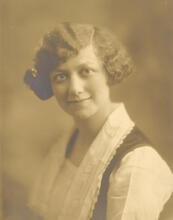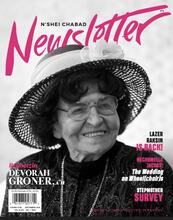Mamie Gamoran
Mamie Goldsmith Gamoran combated assimilation in America by writing children’s books on Jewish history and holidays that encouraged children to feel proud of their dual identities as Jews and Americans. Her own work made a great impact on the field of Jewish education as well: she wrote a three-volume work, The New Jewish History, in the 1950s to give Jewish children the sense that they were participants in an ongoing, exciting tradition. She also wrote a book about Jewish holidays, encouraging children to feel they didn’t have to choose between being Jewish and being American. Gamoran served as a volunteer for Hadassah and as both a national board member and vice president of Histadrut Ivriot of America, an organization that promoted the Hebrew language.
When Mamie Goldsmith Gamoran graduated from the Teachers Institute Extension Course of the Jewish Theological Seminary in 1922, she was acutely aware of how much needed to be accomplished in the field of Jewish education. She was saddened that the youth of her generation had “forged new chains and ties,” thereby dismissing their heritage. As a proud American and ardent Zionist, Gamoran believed that one could synthesize American culture with one’s commitment to Judaism. Although born to parents who were not strongly affiliated Jews, Mamie Gamoran dedicated her life to the Jewish community.
Early Life
She was born on January 17, 1900, in Long Island City, New York, to Mamie Aronson and Nathan Israel Goldsmith. Named after her mother, who died one week after her birth, Mamie had three older siblings, Joseph, Minnie, and Laurette, and also a half-brother, Edwin, born to her father and his second wife, Mathilde Bauer.
Mamie received her formative education in the New York City public school system. She continued her education at Columbia University and the University of Cincinnati but never matriculated at these institutions. Instead, she chose to receive a degree from the Teachers Institute of the Jewish Theological Seminary of America, a decision that best reflects her lifelong commitment to strengthening Jewish life.
Career
Mamie’s interest in the Jewish community and love of Judaism developed in the Association of Jewish High School Girls, led by Leah Konowitz and later Deborah Marcus Melamed. When the association merged with the Association of Jewish High School Boys and became the League of Jewish Youth, Mamie Goldsmith met Emanuel Gamoran, originally from Belz, Russia. Their paths crossed for a second time at the Jewish Theological Seminary, where Emanuel Gamoran was a member of the faculty extension department of the Teachers Institute and Mamie Goldsmith was a student in the first graduating class. They were married on December 17, 1922.
The Gamorans shared a commitment to Jewish education: Both were members of the Bureau of Jewish Education, the first organization in the United States committed to the betterment of Jewish education, under the directorship of Samson Benderly. In 1923, when Emanuel Gamoran was appointed educational director of the Commission on Jewish Education of the Union of American Hebrew Congregations, the Gamorans moved to Cincinnati, Ohio. Although her husband was credited with having revolutionized the curricula and techniques of Jewish religious education, Mamie Gamoran made enormous contributions in this area as well.
Like her husband, Gamoran wrote many textbooks for Jewish schools, including a thoughtful three-volume work, The New Jewish History (1953, 1956, 1957). Its goal was to make Jewish children feel that their history was an unending story, dramatic and challenging, in which they would be future participants. This work reflects her theological leanings as well as her beliefs about how children should be inspired intellectually and emotionally. Her most popular book was Fun Ways to Holidays: A Book of Puzzles Based on American and Jewish Holidays (1951).
Later Life
Concerned that her husband’s books were not readily accessible to the public, Gamoran prepared a bibliography of his writings and following his death coedited his biography, Emanuel Gamoran: His Life and His Work (1979). In addition, Mamie Gamoran wrote a confirmation service for girls, recognizing that they needed a ceremony to mark the completion of the first stage of their Jewish education. She intended this ceremony to be performed on the holiday of Lit. "weeks." A one-day festival (two days outside Israel) held on the 6th day of the Hebrew month of Sivan (50 days, or 7 complete weeks, from the first day of Passover) to commemorate the Giving of the Torah on Mount Sinai; Pentecost; "Festival of the First Fruits"; "Festival of the Giving of the Torah"; Azeret (solemn assembly).Shavuot. Her personal files, containing much unpublished material, testify to her love of and talent for writing. She preferred, however, to spend most of her time writing materials for an audience of Jewish children.
In addition to her writing and synagogue involvement, Gamoran traveled abroad with her husband to carry messages of Jewish education to liberal congregations in England, Ireland, Holland, Rhodesia, and South Africa. She also performed volunteer work for Hadassah as a national board member and for Histadrut Ivriot of America, becoming its vice president. She was also a loving mother to three children: Abraham Carmi, Rabbi Nathaniel Hillel, and Judith Chernin. She taught them at home and spoke to them in Hebrew, hoping to infuse them with a strong sense of Jewish tradition. She also instilled ardent Jewish feelings in her daughters-in-law, treating them as if they were her own daughters. The desire to preserve memories of her family prompted Gamoran to write a memoir to leave for her children, although this extraordinarily modest woman chose not to describe her own accomplishments in it. After her death, her son Nathaniel Hillel ensured that A Family History was published.
Mamie Gamoran died in New York City on July 26, 1984.
Selected Works
Confirmation Service (1948)
Emanuel Gamoran: His Life and His Work, editor with Samuel Grand (1979).
A Family History. Edited by Hillel Gamoran (1985).
Fun Ways to Holidays: A Book of Puzzles Based on American and Jewish Holidays (1951).
Hadassah Handbook, editor with Minnie W. Halpern. 6th ed. (1960).
The Hebrew Spirit in America. Microfilm (1975).
Hillel’s Calendar (1960).
Hillel’s Happy Holidays (1939).
The Jewish Times (1975).
The New Jewish History (1953–1957).
Shimshon Benderly, translator (1963).
The Voice of the Prophets (1929).
AJYB 86:439.
EJ 4:479, s.v. “Samson Benderly,” and 7:308, s.v. “Emanuel Gamoran”.
Gamoran, Mamie. Biographical material. Hadassah Archives, NYC.
WWIAJ (1928, 1938).









